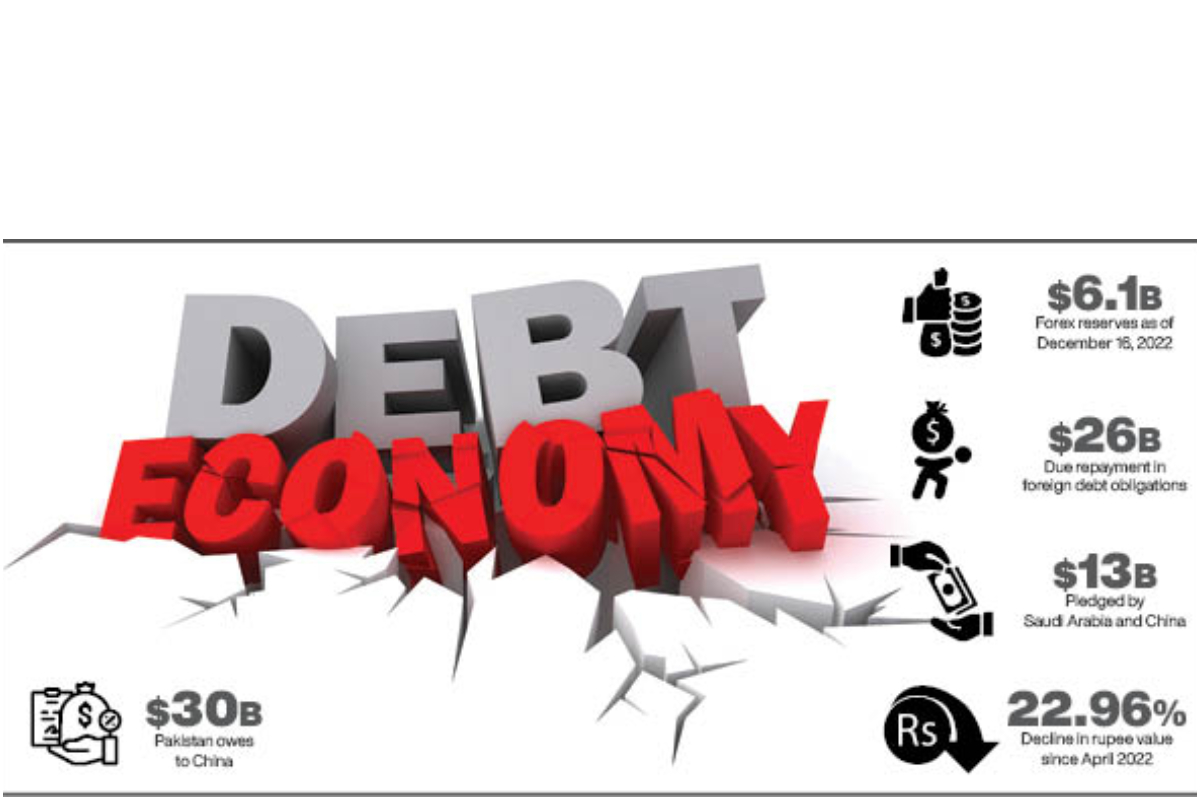
Not a Bed of Roses
Undoubtedly, there are no two opinions about Pakistan going to default in a highly charged political environment created by Pakistan Tehreek-e-Insaf (PTI) Chairman and ousted prime minister Imran Khan.
All the indicators are showing dismal economic conditions in the country with the foreign exchange reserves reaching an alarming level of $6.1 billion, while the country has to repay over $26 billion in foreign debt obligations and bridge the burgeoning current account deficit.
On December 16, the foreign exchange reserves held by the State Bank of Pakistan (SBP) were recorded at $6.1 billion.
The central bank attributed the decline in the official foreign exchange reserves to external debt repayment. The current level of the forex reserves witnessed multiyear low, as the SBP’s foreign exchange reserves stood at $7 billion in April 2014.
The total foreign exchange reserves of the country slipped $570 million to $12 billion by the week ended December 16, 2022 compared with $12.57 billion a week ago.
However, during the week ended August 27, 2021, the foreign exchange reserves held by the central bank soared to an all-time high of $20.15 billion after Pakistan received the general allocation of Special Drawing Rights (SDRs) worth $2.751 billion from the IMF on August 24.
Meanwhile, despite tall claims by Finance Minister Ishaq Dar and a media hype, neither Saudi Arabia nor China has so far provided Pakistan with a financial cushion of around $13 billion to enable it to avoid the bankruptcy.
Pakistan is confronted with the biggest problem of balance of payments crisis, leading to the instability in the ongoing exchange rate and dwindling foreign exchange reserves.
The majority of the economic woes are owing to the growing trade imbalance, as usually, import growth outperforms export growth, while the dollars arrival in the form of remittances and foreign direct investment remained in short supply to bridge the trade gap. As a result, the rupee weakened, as the government inject money in the market, hurting the foreign exchange reserves.
It is evident that the persistent political unrest and the lack of financial support from the International Monetary Fund and friendly countries, if continued for a longer period, the economic conditions of the country would further deteriorate, putting more pressure on the already struggling economy.
Whoever is to blame but the fact is that the financial problems of the people of Pakistan are multiplying manifold with the passage of time, as food inflation is surging on almost daily basis, amid dwindling foreign exchange reserves, while the rupee is on a shaky ground with a massive decline of 22.96 per cent since April 2022. Experts believe that it will continue to decline by the end of June 2023.
According to some reports, the Pakistani government will be unable to sell the debt on the international market under the existing circumstances, showing that the country no longer has the access to the international bond market, which is a big problem.
Everyone is talking about default or in simple words severe monetary crisis Pakistan is confronted with, at present, meaning that the State Bank of Pakistan is short of money. This situation turned out to be fatal for an import-dependent country.
The worrisome issue is that the country needs import of crude oil, refined petroleum products, gas, palm oil, pharmaceutical and other raw materials to meet the domestic requirements but the central bank has been short of greenback.
Some experts endorse the government’s narrative that Pakistan is not going to default on its debt obligations come what may because it has repaid $1 billion worth of Sukuk bonds on December 2, 2022.
The real problem in the future will be the currency default swap (CDS), a financial derivative that allows an investor to swap or offset their credit risk with that of another investor. After touching a record high of 12,388 basis points on November 22, 2022 it fell to 5,882bps, showing a drop of 3,168 basis points. However, in May 2022, the CDS was 1,000 points, indicating that the debt insurance of the country has grown to a shockingly high level.
Although the foreign exchange reserves fell to an all-time low, the political leaders continue to hold out hope that they will get additional funding from the international donors and friendly countries to help ease the burden.
Dar, on a number of occasions claimed that the government has arranged to repay all the international debt obligations and there is no risk of default, as the government was already negotiating a $3 billion payment with an ally other than China and Saudi Arabia.
A good understanding has been reached and Pakistan is likely to get funds in the next two weeks, he claimed on December 2, 2022.
Imran Khan’s irresponsible attitude and the careless policies during his three-and-a-half years of tenure are to blame for the economic meltdown the country is confronted with, at present.
According to the International Monetary Fund (IMF) assessment, Pakistan owed $30 billion to China and its commercial banks, a jump of $2.6 billion from its February assessment of $24.7 billion.
However, during his visit to China, Prime Minister Shehbaz Sharif has been assured that $9 billion in sovereign deposits, currency swaps and commercial loans, would be rolled over. Reportedly, Saudi Arabia has also made similar pledges during the prime minister’s visit.
It has been reported that Saudi Arabia has assured that it would provide $4.2 billion in financing and a deferred oil payment. It had already announced a one-year rollover of $3 billion in deposits for Pakistan.
According to the World Bank’s country overview showed that Pakistan’s economy has been undergoing an overdue adjustment in early 2022, as it recovered from the effects of Covid-19.
The economy grew 6 per cent in 2022, while the coalition government took various decisions and measures to stabilise the economy.
However, owing to the rising energy prices, consistent rupee depreciation and flood-related delays to agricultural production, the growth is now estimated to remain around 2 per cent in FY23. The budget deficit, including grants, is forecast to fall to around 6.9 per cent of GDP.
The authorities need to take concrete measures to smoothly manage the overall economic challenges and avoid these risks by entailing the development and successful implementation of a recovery strategy.
Catch all the Economic Pulse News, Breaking News Event and Latest News Updates on The BOL News
Download The BOL News App to get the Daily News Update & Live News.








 Read the complete story text.
Read the complete story text. Listen to audio of the story.
Listen to audio of the story.